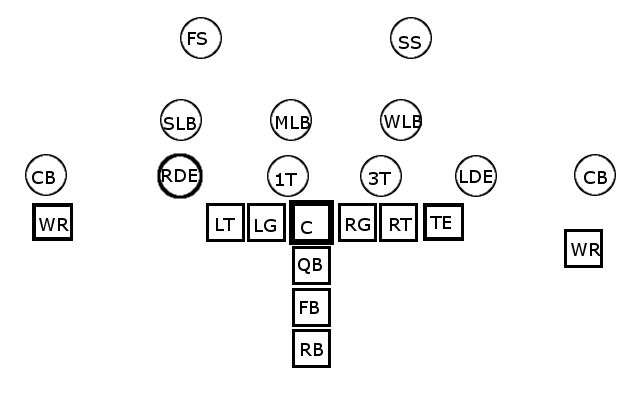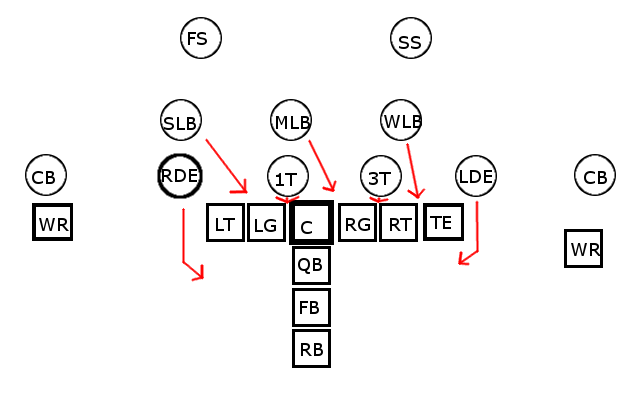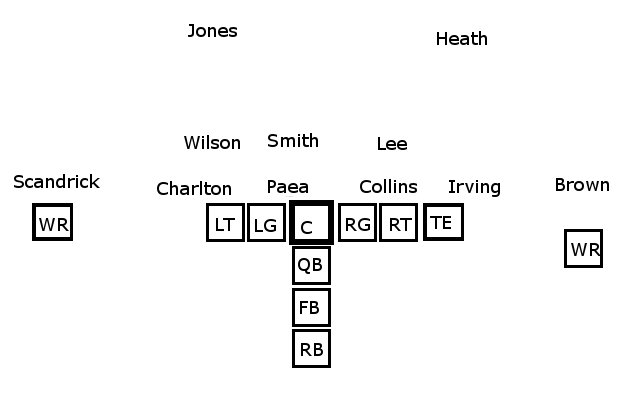In last week’s post, I covered some of the more fundamental defensive football concepts: gaps and defensive linemen techniques. I went through an overview of how gap theory is used to choke running lanes, and we saw how defensive linemen will position themselves in pre-snap techniques to ensure the best leverage against an opposing offensive linemen.
In this week’s post, I want to take those things that we learned, and actually translate them into one of the most fundamental defensive formations in football: the 4-3 over defense.
The 4-3 Over Formation
You’ve very likely already heard of the 4-3 defense, which is also referred to as the “base 4-3” or even the “43.” What you may not know, is the 4-3 front has several different ways for the defensive personnel to line up, depending on what the defensive coordinator will call prior to the play.
Throughout my research, I’m learning that of all the different variations, the “4-3 over”, and the “4-3 under” are the most common formations. In this post, we’ll be focusing on the former, and take a deeper look at the latter next week.
When the offense breaks the huddle, they will come out in a specific type of personnel.
You may have heard phrases such as “11” or “12” personnel. This refers to the number of running backs and tight ends on the field. The number of wide receivers is inferred based on this number, given that there can only be 11 offensive players on the field. For example, 21 personnel means that there are two running backs and one tight end. Therefore, there are three wide receivers, a quarterback, and five offensive linemen, in order to achieve a total of 11 offensive players.
I specify this because the defensive personnel for a particular play will be determined by the offensive personnel. In the case of the 21 personnel example above, the defense will very likely come out in a base 4-3 package, as opposed to something like “nickel” or “dime” packages, which we’ll get into later.
Why? Because of the gap scheme we discussed last week.
If we have a tight end on the field in 21 personnel, how many gaps do we have? You should have counted seven (don’t forget to include the gaps outside of the offensive tackle, and tight end). So in order to combat this, the defense will put out seven defenders to fill all seven gaps.
You may be asking, “What about only six members of the front-7, and a corner to fill the last gap?” With that reasoning, you’ll likely be putting the corner against either the offensive tackle, tight end, or fullback; all of which are likely a winning battle against the smaller-framed cornerback. Thus, the defense will match the offense with its 4-3 formation.
With this scheme, the defensive personnel is as follows:
- 2 defensive ends
- 2 defensive tackles
- 3 stand-up linebackers
- 2 cornerbacks
- 2 safeties
The tight end is the determining factor for the defense as to which side of the offense is referred to as the strong side (or “closed” side). This basically means that if the offense is going to execute a running play, they will go to the side with the tight end because it has more players. Obviously this doesn’t always happen, but that’s the origin behind the strength of the formation.
Another important concept to note, generally, offenses in the NFL are based on a right-handed scheme. What I mean by this is that your left tackle is generally the better pass blocker because he protects the quarterback’s blind side. This means that when a right-handed QB is standing in the pocket, he is unable to see the pass rusher coming from the side of his left tackle. Conversely, your right tackle is generally your mauling run blocker. You generally scheme up your run plays to be run behind your left tackle.
An offensive scheme will not adjust its offensive line personnel to match a left-handed quarterback. Thus, the defensive line will generally maintain its personnel alignments to match the offensive line. Having said that, if the tight end lines up inline (adjacent to) to the left tackle, that now becomes the strong side of the formation, and the front-7 should adjust accordingly.
Why is this important? Because the defense will position their front-7 based on which side of the offense is the strong side.
In the 4-3 defense, you have three stand-up linebackers, most commonly referred to as WILL, MIKE and SAM. Notice the first letter of each of these terms also corresponds to Weak, Middle, and Strong.
In the 4-3 over formation that we’re looking at, the WILL linebacker lines up on the strong side of the offensive formation, behind the 3-technique defensive tackle (the outside shoulder of the strong-side offensive guard), while the SAM will line up behind the right defensive end (pictured below). The MIKE will hover about 4 yards behind the 1-technique.
The DLs also move depending on where the strong side of the formation is. As mentioned earlier, in the 4-3 over, you have two defensive ends (DEs), and two defensive tackles (DTs). In the 4-3 over, both DEs will line up on the outside shoulder of the outer most lineman, including the tight ends.
This results in the weak side end (RDE) beginning the play in 5-technique, while the strong side end (SDE) will line up at 7-technique.

From here, the two corners and two safeties will line up based on the pass coverage assignments, which we’ll cover in a later lesson as well. For what it’s worth, the secondary (i.e. cornerbacks and safeties) is showing a cover-2 look in the image above.
Filling The Running Lanes
Okay, so now we know where the players line up. What now?
At this point, the front-7 is ready for a run play to take place (recall the gaps concept). We know there are seven gaps in the image above; two A gaps, two B gaps, two C gaps, and a D gap outside of the tight end. Because of this personnel, the defense will be able to fill all holes the offensive line can create:

2017 Positional Projections
Looking towards the 2017 NFL season, I’m projecting the following players to be on the field in this formation to open training camp:

As for why I project these players this way and why they’re good (or bad) fits for these positions, we’ll cover that in a future post as well.
Wrapping Up
This is a very simplistic view of the base 4-3 over defense, and there is certainly variance in how players line up, coverages, etc… but, at its simplest view, this is the base 4-3 defense. In next week’s post, I’m looking to cover the 4-3 under defense, how it differs from the 4-3 over, and why the defensive coordinator might choose one formation over another.
For some, this lesson is too rudimentary. To others, it may bring about a good eye opener to the base defensive formation that the Cowboys run. In future posts, I’ll dive deeper into what I’ve learned and researched, and hope that you will learn along with me.
Feel free to drop a comment or reach out to me on twitter @TheLandryTrophy. I’ve also gotten a ton of insight from @JoeyIckes, who I strongly encourage you follow!